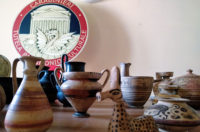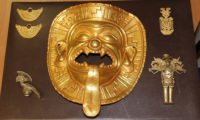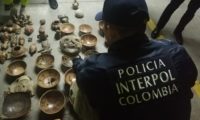 A massive joint international law enforcement effort has resulted in the arrest of 101 suspects in the traffic of antiquities and the recovery of more than 19,000 works of art and archaeological artifacts. The investigations involved Interpol, Europol, the World Customs Organization and national police forces from 103 countries all over the world, including Spain, Colombia, Romania, Argentina, Chile, Latvia, the Czech Republic, Afghanistan and Italy.
A massive joint international law enforcement effort has resulted in the arrest of 101 suspects in the traffic of antiquities and the recovery of more than 19,000 works of art and archaeological artifacts. The investigations involved Interpol, Europol, the World Customs Organization and national police forces from 103 countries all over the world, including Spain, Colombia, Romania, Argentina, Chile, Latvia, the Czech Republic, Afghanistan and Italy.
This intricate global cooperation launched 300 individual investigations in a coordinated crackdown that focused on taking down organized crime networks that loot archaeological sites and museums and pillage war-torn countries.
 Spanish police busted three traffickers and recovered precious objects smuggled out of Colombia. The most unique among them is a gold mask made by the Tumaco people on the Pacific coast near what is now the border between Colombia and Ecuador. They thrived in the area between the 1st century B.C. and 1st century A.D. and are renowned for their goldwork, especially their 3-dimension gold figurines made of sheet gold. Tumaco figurines and finely decorated jewelry were among the confiscated objects. Another nine suspects were arrested in the Spanish operation and Roman archaeological materials — a carved limestone lion, a architectural frieze and three columns — recovered.
Spanish police busted three traffickers and recovered precious objects smuggled out of Colombia. The most unique among them is a gold mask made by the Tumaco people on the Pacific coast near what is now the border between Colombia and Ecuador. They thrived in the area between the 1st century B.C. and 1st century A.D. and are renowned for their goldwork, especially their 3-dimension gold figurines made of sheet gold. Tumaco figurines and finely decorated jewelry were among the confiscated objects. Another nine suspects were arrested in the Spanish operation and Roman archaeological materials — a carved limestone lion, a architectural frieze and three columns — recovered.
 While the busts were going down at Madrid’s Barajas airport and elsewhere in the country, police in Colombia worked the investigation on their end. Raids in Bogotá recovered another 242 pre-Columbian artifacts. It is the largest seizure of cultural patrimony objects in Colombia’s history.
While the busts were going down at Madrid’s Barajas airport and elsewhere in the country, police in Colombia worked the investigation on their end. Raids in Bogotá recovered another 242 pre-Columbian artifacts. It is the largest seizure of cultural patrimony objects in Colombia’s history.
In Argentina, the Federal Police Force seized 2,500 ancient coins by investigating one single online sale. The Latvian State Police took second place in the coin seizure stakes by confiscating 1,375 of them. Customs officers in Afghanistan intercepted and seized 971 cultural objects just before they were smuggled out of the country destined for Istanbul.
Law enforcement officers paid particular attention to the monitoring of online market places and sales sites, as the Internet is an important part of the illicit trade of cultural goods. […]
During what was called a ‘cyber patrol week’ and under the leadership of the Italian Carabinieri (Arma dei Carabinieri), police and customs experts along with Europol, INTERPOL and the WCO mapped active targets and developed intelligence packages. As a result, 8,670 cultural objects for online sale were seized. This represents 28% of the total number of artefacts recovered during this international crackdown.
“The number of arrests and objects show the scale and global reach of the illicit trade in cultural artefacts, where every country with a rich heritage is a potential target,” said INTERPOL Secretary General Jürgen Stock. “If you then take the significant amounts of money involved and the secrecy of the transactions, this also presents opportunities for money laundering and fraud as well as financing organized crime networks,” added the INTERPOL Chief.
“Organized crime has many faces. The trafficking of cultural goods is one of them: it is not a glamorous business run by flamboyant gentlemen forgers, but by international criminal networks. You cannot look at it separately from combating trafficking in drugs and weapons: we know that the same groups are engaged, because it generate big money. Given that this is a global phenomenon affecting every country on the planet – either as a source, transit or destination, it is crucial that Law Enforcement all work together to combat it. Europol, in its role as the European Law Enforcement Agency, supported the EU countries involved in this global crackdown by using its intelligence capabilities to identify the pan-European networks behind these thefts,” said Catherine de Bolle, Europol’s Executive Director.
What country doesn’t have a “rich heritage”?
That mask wouldn’t filter much, but might aid social-distancing in some circles.
England, I guess, since their national collection consists of the cultural heritage looted from other countries. cf. Elgin Marbles, etc.
I would disagree that England does not have a rich cultural heritage – the Romans brought a lot and thoughtfully abandoned large quantities in soggy soil. Just because no one particularly want 2000 year old toilet seats and used writing pads does not mean it is not, um, rich!
Museums in Berlin, Amsterdam, London, Brussels, Paris, Rome, Madrid, and Lisbon are spending a fortune to preserve pieces of art and craft of the bygone eras. Indeed, it is a remarkable gesture of service to the creativity and beauty, unleashed by the supremely gifted artists and craftsmen of different eras.